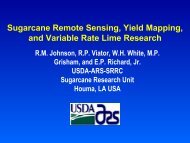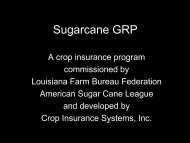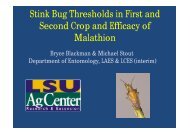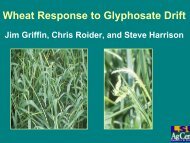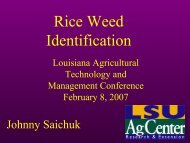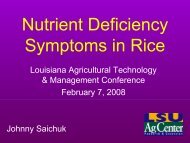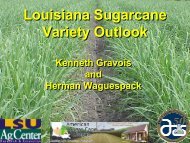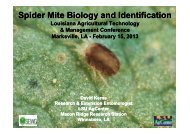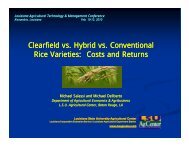New Labels and Insecticide Use Strategies for Rice Water Weevil ...
New Labels and Insecticide Use Strategies for Rice Water Weevil ...
New Labels and Insecticide Use Strategies for Rice Water Weevil ...
You also want an ePaper? Increase the reach of your titles
YUMPU automatically turns print PDFs into web optimized ePapers that Google loves.
<strong>New</strong> labels <strong>and</strong> insecticide use<br />
strategies <strong>for</strong> rice water weevil<br />
control<br />
Michael Stout, LAES & LCES (interim)<br />
Srinivas Lanka, LAES
<strong>Rice</strong> water weevil : key insect pest of Louisiana rice<br />
‣ Most economically damaging insect<br />
‣ Decisions must be made be<strong>for</strong>e planting
Adult<br />
Adult<br />
feeding<br />
overwintering<br />
Larval<br />
feeding<br />
Mating <strong>and</strong><br />
oviposition
<strong>Rice</strong> water weevil insecticides<br />
Furadan
<strong>Rice</strong> water weevil insecticides<br />
Furadan<br />
Pyrethroids+ Icon
<strong>Rice</strong> water weevil insecticides<br />
Furadan<br />
Pyrethroids+ Icon<br />
Pyrethroids
<strong>Rice</strong> water weevil insecticides<br />
Furadan<br />
Pyrethroids+ Icon<br />
Pyrethroids<br />
Pyrethroids+ seed treatments
<strong>Rice</strong> water weevil insecticides<br />
Furadan<br />
Pyrethroids+ Icon<br />
Pyrethroids<br />
Pyrethroids+ seed treatments<br />
Foliar insecticides<br />
Seed treatments<br />
Pyrethroids<br />
(Fastac)<br />
Belay Dermacor CruiserMaxx<br />
NipsitInside
Foliar insecticides<br />
Seed treatments<br />
Pyrethroids Belay Dermacor CruiserMaxx<br />
NipsitInside<br />
•<strong>Strategies</strong>: seed treatments vs. foliars<br />
•NipsitINSIDE label <strong>and</strong> use<br />
• Belay <strong>and</strong> Fastac labels<br />
•<strong>Use</strong> of Belay<br />
•Dermacor in water-seeded rice (24c)<br />
•Neonicotinoid + Dermacor combinations<br />
allows lower Dermacor rates)<br />
•Crawfish impacts<br />
•Other management practices<br />
(2ee
Foliars – Pyrethroids, Belay
Seed treatments – CruiserMaxx, Dermacor X-<br />
100, NipsitINSIDE
100<br />
Percentage Survivors<br />
80<br />
60<br />
40<br />
20<br />
A<br />
B<br />
C<br />
0<br />
0 14 28<br />
TMX treatment rate ( µg AI/seed)<br />
Number of insects / Plant<br />
8<br />
6<br />
4<br />
2<br />
A<br />
Eggs<br />
A<br />
First instars<br />
Larvae<br />
B<br />
B<br />
0<br />
0 14 28<br />
TMX treatment rate (µg AI/seed)
NipsitInside(seed treatment) label<br />
• Active ingredient: Clothianidin (similar to<br />
CruiserMaxx)<br />
• Rate: 1.92 fl oz/100 lbs seed (0.075 lb ai/100<br />
lbs seed)<br />
• For use in dry-seeded rice; seed treatments to<br />
be made by authorized seed treater<br />
• Do not apply > 0.2 lbs ai/acre/year<br />
• “Not to be used in areas where rice/crawfish<br />
aquaculture practices are in place…”<br />
• Aphids, chinch bugs, colaspis, thrips, rice<br />
water weevil
Spectrum of activity<br />
Cruiser/Nipsit Dermacor X-100
Spectra of activity: what pests do they<br />
control?<br />
DermacorX-100 Cruiser/Nipsit<br />
X <strong>Rice</strong> water weevil X<br />
Colaspis<br />
X Colaspis<br />
<strong>Rice</strong> water weevil<br />
X<br />
Stem borers Stem borers<br />
Sucking pests –chinch<br />
bugs, aphids<br />
X<br />
Sucking pests –chinch<br />
bugs, aphids<br />
X<br />
Other Leps–fall<br />
armwyorm<br />
Other Leps–fall<br />
armwyorm<br />
X<br />
South American <strong>Rice</strong><br />
Miner<br />
X<br />
SouthAmerican <strong>Rice</strong><br />
Miner
Fastac(foliar) label<br />
• Active ingredient: alpha-cypermethrin<br />
(pyrethroid)<br />
• Rate: 2.6 to 3.8 fl oz/acre (0.02-0.025 lb<br />
ai/acre)<br />
• <strong>Use</strong> like other pyrethroids<br />
• Do not apply > 11.4 fl oz/acre/year<br />
• “Do not use treated rice fields <strong>for</strong> the<br />
aquaculture …”<br />
• <strong>Rice</strong> water weevil, aphids, armyworms, stink<br />
bugs
Belay (foliar) label<br />
• Active ingredient: Clothianidin<br />
• Rate: 4.5 fl oz/acre (0.075 lb ai/acre)<br />
• <strong>Use</strong> in a manner similar to pyrethroids; hold<br />
water <strong>for</strong> at least 14 days after treatment<br />
• Do not apply > 0.2 lbs ai/acre/year<br />
• “Do not use Belay-treated rice fields <strong>for</strong> the<br />
aquaculture of edible fish <strong>and</strong> crustaceans…”<br />
• Aphids, thrips chinch bugs & seed midge<br />
(suppression), rice water weevil
<strong>Use</strong> of Belay<br />
• <strong>Use</strong> in a manner similar to pyrethroids<br />
• May begin scouting any time after rice<br />
emergence<br />
• Check 10 locations every 3-4 days<br />
• Threshold: adults or fresh feeding scars +<br />
water (“conditions favorable <strong>for</strong> egg-laying”)<br />
• Target: prevention of egg-laying by killing<br />
adults; egg-laying occurs in st<strong>and</strong>ing water<br />
• Applications made shortly be<strong>for</strong>e flooding<br />
have been shown to be most effective
Effectiveness of Belay post-flood foliar<br />
application in water-seeded rice, 2009<br />
Densities of weevil larvae<br />
10<br />
9<br />
8<br />
7<br />
6<br />
5<br />
4<br />
3<br />
2<br />
1<br />
0<br />
21 days post-flood<br />
3.5 or 4.5 fl oz Belay/Acre<br />
Control Karate 1+7 dpf Belay 1 +7 dpf Belay 7dpf<br />
Treatment
Densities of weevil larvae<br />
12<br />
10<br />
8<br />
6<br />
4<br />
2<br />
Effectiveness of Belay post-flood foliar<br />
application in water-seeded rice, 2012<br />
21 days post-flood<br />
0<br />
Control<br />
Belay<br />
2 d 8d<br />
Post-flood<br />
Belay 4.5 fl oz<br />
Karate 2 d<br />
Post-flood<br />
0.04 lbs ai
Efficacy of Belay <strong>for</strong> <strong>Rice</strong> <strong>Water</strong> <strong>Weevil</strong> Control<br />
a<br />
Pre-Flood<br />
Early<br />
Post-Flood<br />
Late<br />
Post-Flood<br />
No. Larvae per Core<br />
b<br />
bc<br />
bc<br />
bc<br />
bc<br />
c<br />
bc<br />
2012
Foliar Application Timings -RWW<br />
No. Larvae per Core<br />
14<br />
12<br />
10<br />
8<br />
6<br />
4<br />
A<br />
A<br />
C<br />
B<br />
C<br />
UTC<br />
Karate (2.56)<br />
Belay (4.5)<br />
C<br />
C<br />
2<br />
0<br />
UTC Pre 1 Day Post 7 Day Post<br />
Application Timing In Relation To Flood 2010
DermacorX-100 water-seeded<br />
label<br />
• 24(c) “Special local need”<br />
• Allows seeding with dry treated seed (no presprouting)<br />
• “For control of Mexican rice borer”<br />
• 100-125 lbs seeding rate: 2.0 fl oz per 100 lb<br />
seed
Dermacor X-100, dry treated seed broadcast<br />
into flood (24c)<br />
<strong>Water</strong> weevil larvae per core,<br />
28 days after flood<br />
20<br />
18<br />
16<br />
14<br />
12<br />
10<br />
8<br />
6<br />
4<br />
2<br />
0<br />
Cocodrie, 100 lbs / A<br />
CL151, 70 lbs / A<br />
0 2.0 1.75 0 2.5 3.0<br />
Dermacor rate, fluid ounces per 100 lbs seed
Dermacor X-100 2(ee)<br />
Recommendation<br />
2(ee) rate (fl<br />
oz per 100 lbs)<br />
<strong>Rice</strong> seeding rate<br />
Approximate<br />
“normal” rate<br />
1.5 80 120 2.0-1.5<br />
1.75 70 79 2.5<br />
2.5 50 69 5.0-2.5<br />
5 20 35 5.0<br />
May allow cost-effective use of<br />
Dermacor/neonicotinoid combinations
Cost of Dermacor/Neonic<br />
• 25 lb seeding rate<br />
combinations<br />
• 5 oz Dermacor per cwt: ~$15.00 per acre<br />
• Nipsit/Cruiser: ~$5.00 per acre<br />
• Total cost: ~$20.00 per acre
<strong>Insecticide</strong>s <strong>and</strong> Crawfish<br />
•All weevil insecticides are toxic to crawfish<br />
•All insecticides have restrictions on labels<br />
Pyrethroids<br />
KarateZ<br />
Mustang Max<br />
Declare<br />
Prolex/Proaxis<br />
Neonicotinoids/<br />
Anthranilic diamides<br />
Dermacor<br />
CruiserMaxx<br />
NipsitInside<br />
Belay
<strong>Rice</strong> water weevil –cultural practices<br />
<strong>Water</strong><br />
management<br />
Plantingdate<br />
Seeding rate<br />
Draining Early planting Avoiding low<br />
seeding rates<br />
Delayed flooding<br />
Shallow flooding
Thank you <strong>for</strong> your support!<br />
Michael Stout<br />
(225) 892-2972<br />
mstout@agcenter.lsu.edu



